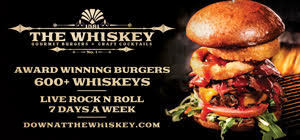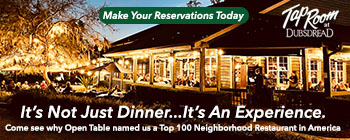This must be a wonderful time to own a churrascaria. Meat, after all, is the darling of the dining scene, and churrascaria means meat.
Well, not literally. Churrascaria (tchoo-huh-scah-REE-uh) actually means house of barbecue, but to fans of this type of Brazilian steakhouse, it means meat, meat and more meat.
Texas de Brazil is a small chain out of, no surprise here, Texas that is riding the wave of low-carb popularity with a new location on International Drive. This isn’t the first churrascaria to open in the area. There have been a few, and just last year we visited another on I-Drive, Crazy Grill, which does a fine job overall.
But Texas de Brazil takes this concept to a new level. The surroundings are almost luxuriant, the service is nearly fawning, and the food is well prepared and plentiful in the all-you-can-eat concept. As to whether the $38.50 charge is a value, that depends on just how much you can eat and still enjoy yourself. I had a good time at TdB, and if you were to have weighed me when I went in and again when I left, I think the price per pound would have made it a bargain.
The first thing you’ll notice about Texas de Brazil is the colorful décor. You’ll probably see it through the windows as you circle the building trying to find the front door. Such is the parking arrangement that the entrance is on the opposite side of the restaurant.
The interior is painted a startling deep ruby red, and throughout the restaurant are gigantic sprays of silk flower arrangements that radiate their colors into the room. Floors are hardwood and tables are covered with white cloths.
The columns and ceiling beams are fashioned to look like iron girders with extruding rivets. I didn’t quite get the connections, but a manager told me later it was meant to look like a large factory in Brazil.
The wine cellar is enclosed in a glass-walled chamber just off the center of the large room. Next to it is a square buffet/salad bar. This is where your meal begins and, if you’re not careful to pace yourself, where it will end too.
The salad selection includes fairly simple greens and dressings, but also has more unusual items, such as tabbouleh, sushi and hearts of palm. In between you’ll find artichoke hearts, Brussels sprouts, asparagus, roasted red peppers, beets, buffalo mozzarella, grilled portobello mushrooms, potato salad and pasta among others.
There are also cauldrons of soup, sauteed mushrooms, black beans and rice. The black beans weren’t very flavorful, and some of the items weren’t worth the wasted calories. The Brussels sprouts, for example, were practically raw, and the sushi wasn’t done well enough to warrant its inclusion on a Brazilian buffet. But the rest of it was perfectly acceptable.
Still, I think I’d rather concentrate on the meats, and wonderful meats they were.
There is a method to the meat service and it requires proactive participation on the diner’s part. Circling throughout the dining room you’ll see a horde of servers, called gauchos after the Portuguese word for cowboys, carrying large skewers and chef knives. Each place setting has a paper disk that is green on one side and red on the other. Place the green side up when you’re ready for meat and these gauchos will stop by to offer you whatever they’re carrying. In some instances the servers fairly swarmed about the tables, descending on diners with flashing knives.
Each diner also has a set of tongs. Some of the meats and sausages are in small chunks, which the gaucho can simply slide off the skewer onto your plate. (All the servers were careful not to allow their skewers to touch a guest’s plate – a sanitation issue.) Other meats, such as top sirloin, leg of lamb and pork ribs, must be sliced. The gaucho makes a small cut and then asks the diner to grab hold with the tongs while he slices through.
The meats were all cooked over charcoal fires and well-seasoned. They were imbued with a smoky taste that complemented the herbs and spices, and the quality of the cuts was unquestionably high. Oh, and as if all that weren’t enough, your lead server will bring mashed potatoes and fried bananas to your table.
If you need a break, or when you think you’ve had enough, turn the disk over to red and the gauchos will pass you by.
If for some reason you still have the ability to eat something more, the Brazilian papaya cream ($6.25) or the chocolate mousse cake ($6.25) for dessert. And for more Brazilian authenticity, try the caipirinha ($7), a drink made with lime, sugar and cachaca.
Texas de Brazil is more expensive than Crazy Grill, but it also offers a more upscale experience, especially considering the International Drive location. If you’re following a low-carb diet, or if you just appreciate good grilled meats, you’ll think you’ve gone to hog – and cow – heaven.
Texas de Brazil is at 5259 International Drive, Orlando. It’s open 5-10 p.m. Sunday-Thursday, 5-10:30 p.m. Friday and Saturday.
Prix fixe $38.50.
407-355-0355
Texas de Brazil
Written By Scott Joseph On July 8, 2006
Seasons 52
Written By Scott Joseph On June 21, 2006
The Seasons 52 that exists today, in the original location on Restaurant Row Orlando and in eight other locations around the southeast, is not exactly the restaurant that it started out to be. But most of the changes have been for the best.
No, there is no butter in the kitchen or anywhere else in the restaurant. But then neither are there rolls nor yeasty hunks of bread to slather it on.
This is Seasons 52, the prototype for a new concept from Darden Restaurants, from whence Red Lobster, Olive Garden, Bahama Breeze and Smoky Bones came. To say that it is different from anything else Darden has done doesn’t go quite far enough. Seasons 52 is innovative on a number of levels, and if it succeeds as a chain – and we’ll discuss that in a moment – it could change the way dine out.
There have been a number of misconceptions about what Seasons 52 is. The name is one of the sources of confusion: it is meant to conjure the notion that instead of four there are 52 seasons of the year, because, culinarily speaking, food items come into season every week somewhere in the world. And to exploit that phenomenon, Seasons 52’s menu changes weekly.
That doesn’t, however, necessarily mean that if you go in one week and find a dish you absolutely love – something that is entirely possible – you won’t see it two or three weeks later when you return. You may see the same dish, but the salmon that came from the northeast last time might now come from the northwest. Or maybe it’s just the tomatoes from that salad that have different points of origin. You may not notice a thing, or you may find you prefer one item over another.
Another misconception is that Seasons 52 is a health food restaurant. It’s true that every item on the menu is engineered to be nutritionally balanced and have fewer than 475 calories. And fried is considered a dirty word. But to call it a health food restaurant conjures images of bran muffins and tofu bean cakes. This is hardly the place where you’ll see people wearing earth shoes and hemp vests.
Then there is the notion that this was somehow supposed to be a chainable California Grill. That stems from the team of George Miliotes and Clifford Pleau, who guided the Disney World restaurant to its reputation as one of the best restaurants in Florida. Miliotes is again the manager extraordinaire, whose devotion for fine wines has been put to great use with a phenomenal global wine list (with no fewer than 56 selections available by the glass), and Pleau assumes the helm of executive chef, assisted by Toni Robertson, formerly of Sonona Mission Inn and Spa in California. But this is not California Grill.
But then there is that char crusted pork tenderloin ($14.75) on the menu. It was served with creamy corn polenta, roasted mushrooms and a cabernet jus that looked and tasted for all the world like Pleau’s signature dish from CG. And if it had been reimagined to fit into Seasons’ mission, it didn’t lack in taste or substance. It was, as it always has been, a favorite.
I also liked the oak grilled ruby trout ($14.75), which anywhere else might have been brushed with butter while grilling to give it extra flavor and moistness, but the butterflied fillet was fine by itself, a full-flavored fish with a mouth-filling texture. It was served with wild rice, simple slices of tomatoes that burst with flavor, and broccolini.
Simplicity was the key for the grilled jumbo sea scallops ($17.95), big, thick discs of tenderness, served with orzo, and grilled asparagus. And lest you think a kitchen counting calories would never feature a juicy steak, the grilled filet mignon ($19.75) will convince you otherwise. It was a meltingly tender hunk of meat, seemingly larger than its advertized six ounces, and coated with a tamarind glaze. This, by the way, was the most expensive item on the menu.
And while the bread basket has been banished, there are some breads of a sort. There are a number of flatbread appetizers, not quite crackers, not quite pizzas. My guest and I had the spicy firecracker shrimp flatbread ($9.75), topped with chili peppers and caramelized mozzarella. It was not light on the spice.
Other appetizers included a large bowl of Prince Edward Island black mussels ($8.50), steamed in chardonnay and flavored with shallots, which made a modest broth; and a rather ho-hum presentation of tamarind glazed chicken breast skewers ($7.25), although the pineapple salsa that accompanied them was wonderful.
You’d be hard pressed to find a more satisfying salad than the one of Early Girl and Sungold tomatoes ($5.75) topped with pleasantly bitter watercress and sprinkled with salty blue cheese crumbles.
Instead of going sugar-free on the desserts, although there might be one or two so promoted, the tray features an array of “mini indulgences,” shooter-sized shot glasses all sorts of goodies for $1.95 each. I especially liked the bing cherries jubilee and the carrot cake with rum raisin sauce.
The dining room exudes warmth with its dark woods, stone, comfortable booths and mood-setting lighting. There are a couple of large trees in the center of the room that look as though they’d rather be outside, but otherwise it’s a lovely ambience.
Service was superior. Menu knowledge was first-rate and the staff all carried themselves with professionalism. Another innovation that Seasons 52 is using is handheld devices that allow the servers to take orders electronically and send them instantaneously to the kitchen. It also allows credit cards to be processed right at the table – or curbside if you call in for takeout. There are still some kinks to work out, such as when buttons are accidentally punched and phantom orders sit on the pick-up counter, but they’re eventually figure it out.
The remaining question is whether Seasons 52, which has become instantly popular and is crowded most evenings with people willing to wait an hour or more, can work as a multi-unit chain. It would seemed to me you would have to clone Miliotes and Pleau, because certainly their mark is one this prototype. But they’ve also shown themselves to be masters of training, and if they can find the right people, die-hard foodies who share their passion for excellence in whatever they do, then there will be a Seasons for everyone.
Harmoni Market College Park
Written By Scott Joseph On June 5, 2006
I’m pleased to say that Harmoni Market in College Park seems to have found its voice.
When I first told you about Harmoni, the then-new eatery/ market didn’t quite seem to know what it wanted to be when it grew up. The market made a Moscow grocery store look well-stocked, and the food in the cafe was underportioned and overpriced, and too little of it was noteworthy for taste or quality.
But a new menu was released in June, and when I stopped by for a revisit I was impressed with what I saw, and especially what I tasted.
My guests and I started with the mezze, an array of appetizing bites that included hummus, sweet roasted tomatoes, compact stuffed grape leaves, tzatziki and olive tapanade.
One of my companions had the U-10 scallops, which sounds like a really weird band but were actually large scallops, deftly cooked, accompanied by a creamy risotto and sea beans.
I also sampled the Tanglewood Farms free-range bone-in chicken breast, served with baby carrots and turnips au gratin. The meat was tender and juicy and had a lovely mild flavor.
Seafood diablo had linguini tossed in a tomato sauce tinged with cream and made devilish with some crushed red pepper.
Harmoni Market is involved in Orlando’s nascent slow-food movement and is dedicated to serving natural meats and local products. It isn’t always easy — there aren’t enough locally raised meats and produce to fulfill a menu’s promise, but at least they’re trying.
And now they’re also succeeding in more ways. I had hedged my recommendation of Harmoni last year; I’m now happy to endorse it wholeheartedly.
(The Market part of the business is still a bit meager, but let’s end on a positive note.)
Harmoni Market is at 2305 Edgewater Drive, Orlando. Cafe hours are 11 a.m. to 10 p.m. Sunday through Thursday and 11 a.m. to midnight Friday and Saturday. Beer and wine are available, and credit cards are accepted. Entrees are $11 to $23. The phone number is 407-206-0033.
Ulyssee’s Prime Steak House
Written By Scott Joseph On June 1, 2006
I’m just going to come right out and say this at the beginning and get it over with: Ulysses’ Prime Steakhouse is a restaurant of the highest caliber and may very well be one of the best in Central Florida.
That it should be located in Cocoa (Village, not Beach) makes it all the more delightful.
It was complete serendipity that I happened upon Ulysses’. I was on my way to Café Margaux, because after almost 12 years since visiting that fine restaurant I thought it was time to go back and check up on it. I had to pass Ulysses’ to get to Café Margaux, and it wasn’t until a few days later that I discovered both restaurants are owned by the same people, Alex and Pamela Litras.
Café Margaux has continued quietly over the years to provide east coasters with a brand of moderately upscale dining, a tad frilly in the décor, perhaps, but with delicious continental cuisine. Even though my absence lasted a dozen years, I continued to hear from satisfied diners that things were status quo, and my own recent experience proved that if the years had done anything at all to Café Margaux it was all on the plus side.
But Ulysses’ Prime Steakhouse is a different dining experience. It is more upscale, both in food and décor, and it offers a quiet and intimate dinner of exquisitely prepared food served with absolute precision.
One of the finest items I sampled was the seared duck liver, which though priced like an entrée at $19 was one of the standout appetizers and easily worth its cost. It featured a beautiful fat lobe, dearingly sauteed with figs braised in sauterne then glazed with mandarin-infused black pepper. It was served on challah toast and topped with chervil. Too many chefs feel a need to go overly sweet with foie gras; the chef here knows how to grace the taste of the liver instead of masking it.
Nearly as good were the diver scallops ($15), monster-sized mollusks served on the half shell with a tangy relish of kalamata olives.
The kalamata is clue to the underlying theme of the restaurant, which, as scholars of Homer will have guessed from the restaurant’s name, is Greek. Litras was attempting to pay homage to his heritage, but the Greek items tend to be the ones that don’t work. That may be because there are but a few passing nods to Greek cuisine.
Avgolemeno ($7) is one. The traditional chicken soup thickened with egg and tinged with lemon can be quite good when done well, but it is still a pedestrian soup that doesn’t blend well into a high cuisine menu. But the Greek notes are rare on the menu, and I’m grateful for that. I love Greek food, but to work it into this environment would have been a detriment.
Once you get past Ullyses’ in the restaurant’s name, you’re left with the words Prime Steakhouse, and that is were the Litras’s wisely focused their attention. The steaks were quite simply wonderful.
The menu features some Wagyu beef selections, though they are of course the domestic variety. True Japanese Wagyu can fetch astronomic prices. But the domestic variety sold here is fairly pricey, too.
How’s $56 for a 16-ounce Wagyu ribeye? For the true connoisseur it’s a mere pittance. The meat fairly meltet on the plate, let alone in the mouth. And it was cooked perfectly to the requested medium-rare. When you’ve got a product that costs as much as this does, you need a grill cook who isn’t constantly cooking re-dos.
I also had the Wagyu short ribs ($35), braised in a ragout of roasted vegetables and rose wine. The meat was delightfully fatty and coated the mouth with richness. The three ribs were served on a pallet of risotto blended with parmesan cheese and roasted garlic.
From the non-Wagyu meat list, the filet mignon stuffed with crab meat ($45) was a study in overindulgence. The USDA prime meat would have been treat enough; so could the lump crab meat that covered it. Put the two together and you’re willing to sacrifice an artery or two.
Meats are served with four sauces, served in ramekins arranged on a tiny bridge. They included rosemary cabernet demiglace de veau; chocolate demiglace de veau; pink and green peppercorn; and Maltaise, a hollandaise tinged with 150th Anniversary Grand Marnier for a slight orange flavor. All were good, but frankly the meat didn’t need saucing.
For dessert, bread pudding ($6), made with challah and dates, figs, raisins and apricots, was heavenly. The bread was custardized to a creamy texture and then sauced with rum caramel. And the macadamia pecan baklava ($8) was unlike any I had tasted before, covered with a tangerine glaze and drizzled with Mt. Ranier fireweed honey. Remember what I said before about the Greek theme not working on the menu? Forget it.
Service was positively top-notch. It wasn’t just the attentiveness – something that shouldn’t be hard in a restaurant with only 36 seats – it was also the intuitiveness, the ability to know what the diners want before they ask for it. Sometimes before they even realize they want it.
Pamela Litras designed the décor, which is sumptuously lush without being gaudy. Yards of alternating fabrics swoosh down the windows. Tables are draped with crisp white linens. And the kitchen is only slightly hidden behind glass panels that look as though they’ve been smeared with chocolate. The panels slide apart for kitchen staff to pass plates to the servers, like it was some elaborate Horn & Hardart’s automat.
I told you my assessment of Ulysses’ Prime Steakhouse at the top. There’s only one thing left to say: go.
Aubergine Bistro
Written By Scott Joseph On May 16, 2006
I don’t often have the chance to go back to restaurants unless there has been a major change, a new menu, new concept, different chef or word that there has been a drastic change in the quality, good or bad.
In the case of Aurberinge Bistro, which I first reviewed in early 2000, there were never any indications over the years that anything had changed. In fact, the tiny bistro in Casselberry often slipped my mind when I would try to think of places to recommend in that area. It just kept quietly offering its simple yet good food in an unassuming manner. When I dined with friends earlier this year it was just for fun. I didn’t realize than that it would be the last meal I’d have from then-owner Bernhard Schwab.
Word came a couple of months ago that Schwab had sold the restaurant to Paul D’Amelio and his parents, Mike and Judy. So, then, it became one of those conditions that warranted a revisit.
I’m delighted and relieved to report that anyone who knew Aubergine Bistro before will find it largely unchanged. There are still some things done quite well, — exquisitely, even – and some things that fall flat. But overall it is still a lovely and unassuming café that obviously strives to produce a quality meal.
I was glad to see the signature Aubergine Napoleon appetizer ($8) is still on the menu and still easily one of the best things to come out of the kitchen. It’s a stacked tower of alternating layers of grilled eggplant, tomatoes and creamy-firm goat cheese with fresh basil and drizzles of balsamic vinegar. Instead of slashing through the layers, or toppling it over, one need only lift off the top three layers and leave the rest for one’s tablemates to do the same. What wonderful flavors of the smoky aubergine and tangy yet creamy chevre, and the red pepper coulis sauce was a perfect accompaniment. Even if more menu changes are in the future, this should be written in indelible ink.
Wild mushroom and andouille sausage ($8.99) was another winning starter. It had the main ingredients finely chopped and seasoned with fresh sage all rolled up in flaky phyllo dough, fried and served like some sort of cajun egg roll, with a creamy Boursin cheese sauce.
Stuffed mushroom caps ($8.50), tiny buttons filled with a crabmeat mix that included sun-dried tomatoes, were fairly pedestrian. But a soup of the day ($5), a creamy mushroom, was filled with lots of chewy mushrooms in a rich and flavorful broth.
Sea scallops Provencale ($19.95) was one of the better entrees. It featured thick, pan-seared scallops, the outsides brown and crisped and the insides still warm and moist, served with chopped tomatoes, mushrooms and a hint of garlic in a wine sauce.
One of my guests had the chicken cordon bleu ($18.50), which was offered as a special of the day – and I’ll have a word about the specials in a moment. The breast meat was rolled and baked the slices so the ham and cheese inside peeked out. It was served, as many of the main dishes were, with simply steamed veggies, uncomplicated and unadorned.
Our server told us the new chef seemed to like cooking fish, so I chose one of the fresh offerings, a wahoo ($23.50). It was the only complete stumble I saw from the kitchen, but it was a big one. The fish was hard and dry and not even the buttery sauce that came with it could do anything to save it.
That fish was one of three offered as a special of the day, along with the chicken dish and one or two other dishes. Each was recited by the server with details of the preparation and the sauces, and each time she moved on to the next one I completely forgot what she’d said before. When there are that many specials they should be written down. Surely there’s a printer somewhere in the office, or they could buy a blackboard for the dining room. Something.
When dessert time came there was another litany of items not printed on the menu. The white chocolate bread pudding ($5.50) was firm and had little surprises in the form of cranberries and almonds. The carrot cake ($6.50) was a tad dry, but the crème brulee ($6.50) had a rich and creamy custard under a crust that was only slightly burned.
Little has changed in the interior – not much that could be done with a small space that seats barely 40. But it’s pleasant enough, comfortable and welcoming.
D’Amelio could easily continue the quiet tradition of Aubergine Bistro and maintain a steady following. But I hope that as he becomes more comfortable with his new restaurant he’ll try new things and turn it into the sort of place that one wants to visit more often.
Aubergine Bistro is at 1455 State Road 436, Casselberry. It is open for lunch Tuesday-Friday and dinner Tuesday-Saturday. The restaurant does not currently have its own Web site. The phone number is 407-678-3300.









